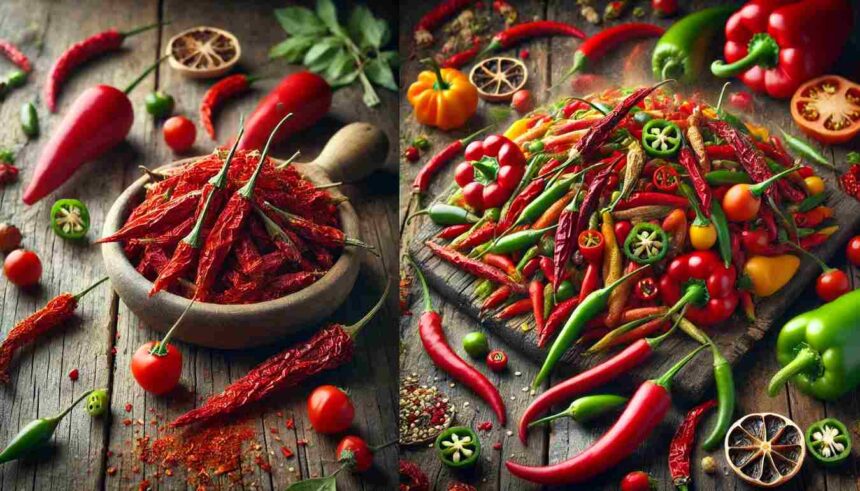When it comes to spicy food, many people are familiar with both peperoncino and chili, but they might not know the exact differences between the two. Although both are types of hot peppers, they come from different regions and have distinct characteristics.
What is Peperoncino?
Peperoncino (pronounced “pep-er-on-chee-no”) is the Italian word for hot chili pepper, commonly used in Italian cuisine. The name peperoncino refers to a variety of small, red, and fiery peppers that are often dried and used to add spice to Italian dishes.
These peppers are typically small and slender, and they pack a punch in terms of heat. While there are many types of hot peppers, peperoncino is most commonly associated with the region of southern Italy.
Peperoncino is a key ingredient in many Italian dishes, especially in the south. It is used in sauces, pasta dishes, and even on pizza. One of the most famous ways to use peperoncino in Italian cuisine is in Spaghetti Aglio e Olio, a simple pasta dish made with garlic, olive oil, and dried peperoncino peppers.
What is Chili?
Chili, on the other hand, is a term used more broadly to refer to any number of hot peppers found around the world.
Chili peppers come in various shapes, sizes, and heat levels, depending on the variety. The term chili is most often associated with peppers from the Capsicum family, including varieties like jalapeños, habaneros, and serranos.
Chili peppers are used in many cuisines worldwide, particularly in Mexican, Indian, and Thai food.
They can be fresh or dried, and their heat levels vary significantly. Some chili peppers, like the mild poblano, are used for flavor without much heat, while others, like the fiery habanero, can bring intense spice to a dish.
Peperoncino vs. Chili: Key Differences
Now that we know what peperoncino and chili are, let’s take a closer look at their key differences:
1. Origin and Geography
One of the most significant differences between peperoncino and chili is their origin. Peperoncino is a staple in Italian cuisine, especially in the southern regions such as Calabria.
It is typically associated with Italian cooking and is a central ingredient in many traditional Italian dishes.
Chili, on the other hand, is used worldwide, from Mexico to India to Southeast Asia. Different countries have different varieties of chili peppers, each with its own flavor and heat level.
For instance, jalapeños are commonly used in Mexican food, while Thai cuisine relies heavily on bird’s eye chili peppers.
2. Size and Shape
Another difference is the size and shape of the peppers. Peperoncino peppers are typically small and thin, usually about 3 to 5 inches long.
They are often dried before being used, although they can also be used fresh. The dried form is often crumbled or ground into flakes to be added to dishes.
Chili peppers, on the other hand, can vary widely in size and shape. Some varieties are small and thin, like peperoncino, but others, like bell peppers, are large and thick-walled. Chili peppers also come in many different colors, including red, green, yellow, and purple.
3. Heat Level
Peperoncino peppers are known for their heat, but they are generally less spicy than some of the hottest chili peppers.
On the Scoville Heat Scale (which measures the heat of peppers based on the amount of capsaicin they contain), peperoncino typically rates between 1,000 and 5,000 Scoville Heat Units (SHUs), depending on the variety.
Chili peppers, however, can have a much wider range of heat. Some chili peppers, like the mild bell pepper, have little to no heat, while others, like the habanero or Carolina Reaper, can reach over 1 million SHUs. This wide range of heat levels makes chili peppers more versatile in terms of flavor and spice.
4. Flavor Profile
While both peperoncino and chili peppers add heat to a dish, their flavors can differ. Peperoncino tends to have a sharp, bright, and slightly smoky flavor when dried. This makes it perfect for Italian dishes like pasta, where it can add spice without overwhelming other ingredients.
Chili peppers, depending on the variety, can have a broader range of flavors. For example, jalapeños have a fresh, grassy flavor, while habaneros have a fruity, slightly citrusy taste.
Some chili peppers, like chipotle, have a rich, smoky flavor, while others, like Thai bird’s eye chilies, are known for their intense heat and sharp flavor.
5. Culinary Use
Both peperoncino and chili peppers are used to add heat and flavor to food, but they are used in different ways depending on the cuisine.
In Italian cuisine, peperoncino is often dried and crumbled into sauces, pastas, and pizza. It is also used in olio e aglio (garlic and olive oil) to create a spicy base for pasta dishes.
In contrast, chili peppers are used in a wide variety of cuisines. They are commonly used in fresh salsas, stews, curries, and stir-fries.
Chili peppers are also often pickled or dried and used in spice blends, such as chili powder, which is a common ingredient in Tex-Mex and Indian cooking.
How to Use Peperoncino and Chili in Cooking
Now that we understand the differences between peperoncino and chili peppers, let’s take a look at how you can use both in cooking.
Peperoncino in Cooking
Pasta Dishes: Spaghetti Aglio e Olio is a classic Italian dish that uses peperoncino. Simply sauté garlic in olive oil and add dried peperoncino for a quick and spicy pasta dish.
Pizza: Crushed peperoncino can be sprinkled on top of pizza to add heat and flavor.
Sauces: Add dried peperoncino to tomato-based sauces for a little extra spice.
Seasoning: Use crumbled dried peperoncino in marinades or dressings to add a kick.
Chili in Cooking
Curries and Stews: Fresh chili peppers are often added to curries and stews to enhance the flavor and provide heat.
Salsas: Chili peppers, like jalapeños or serranos, are commonly used in fresh salsas to add spice.
Stir-Fries: Chili peppers are a key ingredient in many Asian stir-fries, giving the dish a burst of flavor.
Spice Blends: Chili powder, made from dried and ground chili peppers, is used in spice blends for dishes like chili con carne or tacos.
FAQs
1. What are pepperoncini?
Pepperoncini are small, spicy chili peppers commonly used in Italian cuisine. They are typically about 2 to 3 inches long, with wrinkled skin that ripens from green to red. While they originated in Italy and Greece, their popularity has spread worldwide.
2. How spicy are pepperoncini?
On the Scoville Heat Scale, pepperoncini measure between 100 to 500 Scoville Heat Units (SHUs), making them quite mild. For comparison, jalapeño peppers average around 5,000 SHUs, so pepperoncini are significantly less spicy.
3. Are pepperoncini the same as banana peppers?
Pepperoncini and banana peppers are similar but not identical. Both are mild, yellow-green peppers, but pepperoncini tend to be slightly spicier and have a tangier flavor, especially when pickled.
4. How are pepperoncini typically used in cooking?
Pepperoncini are versatile in the kitchen. They are commonly pickled and served as appetizers, added to salads, sandwiches, and pizzas, or used to spice up pasta dishes like spaghetti aglio e olio.
5. Can I eat pepperoncini raw?
Yes, you can eat pepperoncini raw. They have a mild heat and a slightly sweet flavor, making them a tasty addition to salads and sandwiches.
6. How should I store fresh pepperoncini?
Fresh pepperoncinishould be stored unwashed in a paper bag in the vegetable crisper drawer of your refrigerator. This helps maintain their freshness and prevents mold.
7. How long do pickled pepperoncini last?
Unopened jars of pickled pepperoncini can last up to one year when stored in a cool, dark pantry. Once opened, they should be refrigerated and consumed within 2 to 3 months for optimal flavor and quality.
8. Can I substitute pepperoncini with other peppers?
If you can’t find pepperoncini, banana peppers are a suitable substitute due to their similar flavor and heat level. Hungarian Wax peppers can also be used but are slightly hotter.
9. Are pepperoncini healthy?
Yes, pepperoncini are low in calories and contain nutrients like vitamins A and B6. They also contain capsaicin, which can aid digestion.
10. Where can I buy pepperoncini?
Pepperoncini are widely available in grocery stores, typically found with other pickled products. You can also purchase them online through various retailers.
11. How do I know if pepperoncini have gone bad?
Signs of spoilage in pepperoncini include mold growth, discoloration, or a cloudy brine in pickled peppers. If the jar doesn’t make a popping sound when opened or emits an off odor, it’s best to discard it.
12. Can I grow pepperoncini at home?
Yes, pepperoncini are relatively easy to grow in home gardens. They thrive in warm climates with plenty of sunlight. Consider starting seeds indoors before transplanting them outdoors to ensure a successful harvest.
13. What’s the difference between pepperoncini and chili peppers?
While both are chili peppers, “pepperoncini” specifically refers to certain small, mild varieties popular in Italian cuisine. In contrast, “chili peppers” is a broader term encompassing various peppers worldwide, ranging from sweet to extremely hot.
14. How do I incorporate pepperoncini into my diet?
You can add pepperoncini to salads, sandwiches, pizzas, or pasta dishes. They also make a flavorful addition to antipasto platters or can be enjoyed straight from the jar as a snack.
15. Are there any festivals dedicated to pepperoncini?
Yes, the annual Peperoncino Festival is held in Diamante, Calabria, Italy. The festival celebrates all things peperoncino, featuring food stalls, cooking classes, and even a peperoncino-eating contest.
























